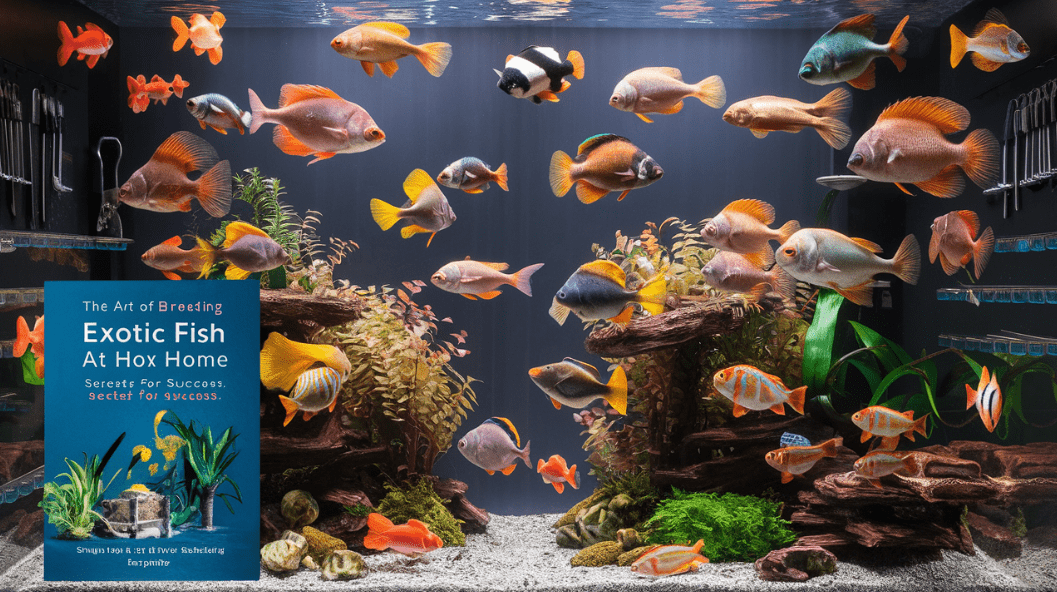Table of Contents
Breeding exotic fish at home can be a fascinating and rewarding hobby, transforming your aquarium into a vibrant underwater world. While this process can seem daunting initially, understanding the right techniques and creating a conducive environment can lead to great success. In this article, we’re diving deep into the secrets that can help you successfully breed exotic fish at home.
Introduction
Have you ever gazed into an aquarium and wondered about the magical world within? If you’re an aquarium enthusiast, you’re likely familiar with the unique charm that exotic fish bring to any tank. But, have you considered taking your passion a step further by breeding these captivating creatures at home? This article reveals the secrets to mastering the art of breeding exotic fish, discussing everything from ideal tank conditions to understanding fish behavior.
Setting Up the Perfect Environment
Choosing the Right Tank
The journey to successful fish breeding begins with selecting the right tank. The size, shape, and material of the aquarium can significantly impact the breeding process.
- Tank Size: Larger tanks provide ample space for fish to swim, reproduce, and grow. A minimum of 20 gallons is often recommended for breeding purposes.
- Shape: Rectangular tanks usually offer better surface area for air exchange and more stable water conditions.
- Material: Glass tanks are popular for their clarity, but acrylic tanks are lighter and more impact-resistant.
“A well-chosen tank is the foundation of a thriving aquatic ecosystem.”
Creating the Ideal Water Conditions
Exotic fish thrive in specific water conditions. Understanding and maintaining these conditions is crucial for successful breeding.
- Temperature: Most exotic fish prefer water temperatures between 75-80°F. Use a reliable heater and thermometer to maintain consistency.
- pH Levels: Different species have varying pH preferences. Regularly monitor and adjust pH levels to suit your fish’s needs.
- Water Hardness: Similar to pH, water hardness should align with the natural habitat of your fish species.
External Resource:
Water Chemistry for Freshwater Aquariums
Understanding Fish Behavior
Identifying Breeding Pairs
The next step is identifying potential breeding pairs. This can be one of the trickiest parts as it often involves observing behavior and physical attributes.
- Behavioral Signs: Look for signs of courtship, such as chasing, fin flaring, or color changes.
- Physical Attributes: Males and females often have distinct differences in size, coloration, and fin shapes.
Encouraging Breeding Behavior
Once you’ve identified your breeding pairs, the focus should shift to encouraging their breeding behavior.
- Diet: Provide a high-quality, varied diet rich in proteins to enhance breeding prospects. Live foods like brine shrimp or bloodworms can be particularly stimulative.
- Environmental Enrichment: Enhance the tank with plants, rocks, or breeding caves to mimic natural habitats.
The Breeding Process
Spawning Techniques
Different species have unique spawning practices. Here, we’ll break down a few common methods.
Egg Scatterers
Many fish, like Tetras and Barbs, scatter their eggs in the substrate or among plants. To breed these fish:
- Provide densely planted areas or fine-leaved substitutes like spawning mops.
- Remove adults post-spawning to prevent egg predation.
Bubble Nest Builders
Betta fish and Gouramis build bubble nests at the water’s surface. To support these breeders:
- Ensure calm water surfaces, free from filtration currents.
- Ensure male and female interactions are monitored to prevent aggressive behavior.
Post-Spawning Care
The care doesn’t end post-spawning. This stage is critical for the survival of the fry.
- Separate Breeding and Rearing Tanks: Protect fry from potential predators, including adult fish, by using a separate rearing tank.
- Feeding Fry: Start with infusoria or commercially available fry foods. Gradually transition to more substantial food as they grow.
Internal Resource:
A Guide to Fish Fry Care in Home Aquariums
Troubleshooting Common Issues
Despite your best efforts, breeding exotic fish can present unexpected challenges. Here’s how to tackle some common issues:
Infertile Eggs
Infertile eggs often result from poor water conditions or incompatible pairs. Regularly test and adjust water parameters and ensure your fish are healthy and well-fed.
Aggressive Behavior
Aggression can stem from overcrowding, incorrect tank setups, or incompatible species. Observe interactions and adjust tank conditions or remove problematic fish as needed.
Conclusion
Breeding exotic fish at home can be an incredibly fulfilling experience when approached with the right knowledge and preparations. From setting up a suitable tank environment and understanding fish behavior to managing the breeding process and troubleshooting, each step requires patience and attention to detail. Remember, each fish species has unique needs, and ongoing learning and adaptation are key. So, ready your tanks and embark on this fascinating journey of creating life in your aquatic world!
“Breeding fish is not just a hobby; it’s a commitment to understanding and nurturing the delicate balance of aquatic life.”
If you found this article helpful, share your breeding stories or questions in the comments below. Happy fish breeding!
(Note: For more detailed species-specific breeding guides, consider visiting reputable aquarium resource sites or consulting with local fish breeding experts.)
